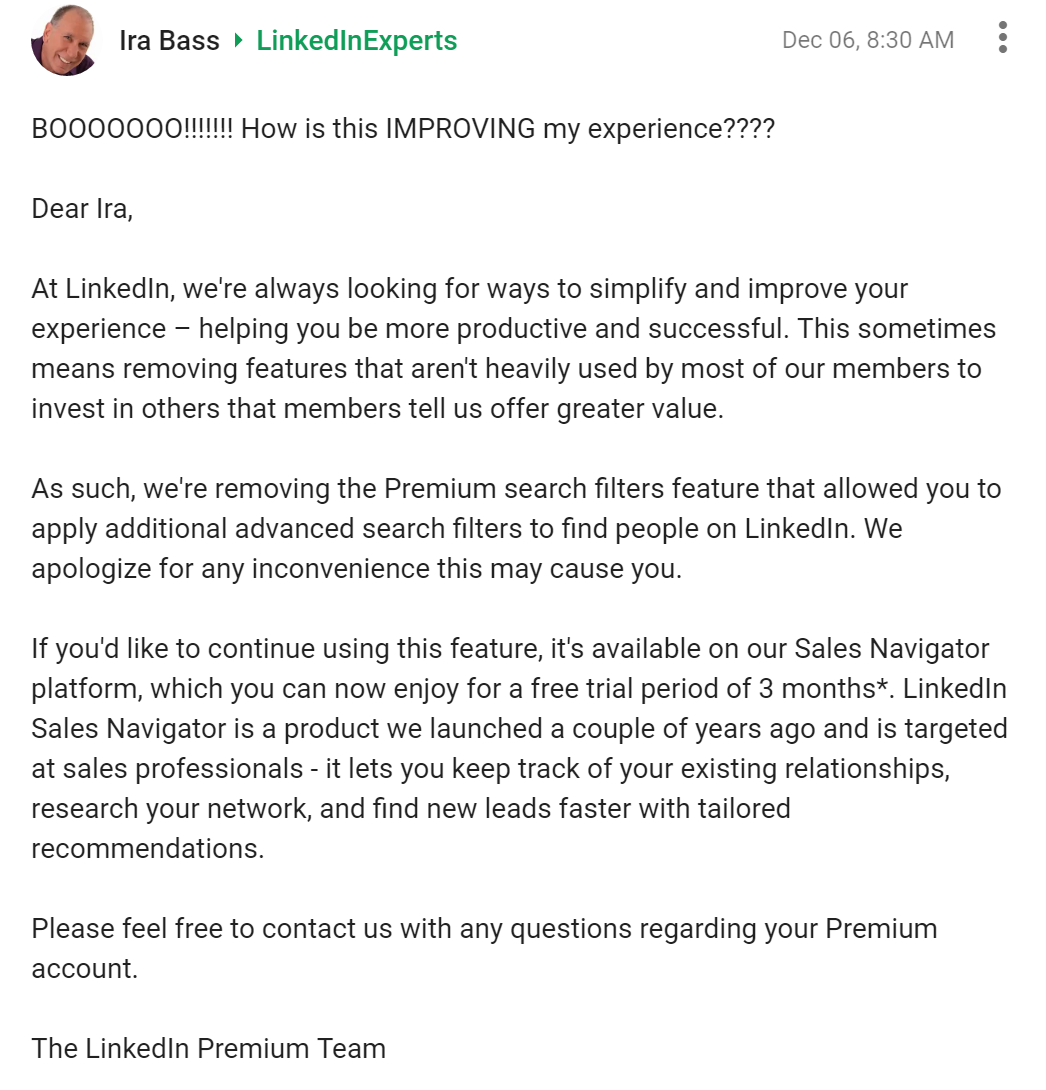Editors Note: For the last 16 days of December, SourceCon will be resharing our most popular articles from the year.
Abraham Lincoln once said, “Give me six hours to chop down a tree, and I will spend the first four sharpening the axe.” Well, Abe sure did know what he was talking about because when it comes to sourcing, the very same principle applies! As tempting as it is to do a broad LinkedIn search to get the lay of the land for a position that you’re recruiting for, it’s far more beneficial to spend a bit of time ‘sharpening your metaphorical axe’, so that when it’s time to run your search, you’ll not only know exactly what it is that you’re looking for, but you’ll ultimately be saving yourself a lot of time and hassle in the long run.
Today, we’re listing the seven things that you NEED to do before you start a LinkedIn search. Whether you’re an agency or in-house recruiter, we guarantee that if you set some time aside at the beginning of the process to mark these things off your checklist, you’ll ultimately be doing yourself a huge favor.
1: Talk to the Client/Hiring Manager
The first thing that you need to do before you even think about opening LinkedIn in your browser is to sit down with the hiring manager/client and have a conversation to better understand the position that you’re sourcing candidates for. Ask questions like ‘What does the perfect candidate look like?’, ‘What do you want from a candidate in terms of skills?’, ‘What requirements are listed in the job description, but aren’t necessarily deal-breakers?’ It really doesn’t matter if you’ve sourced for the same position a thousand times before – you should NEVER assume that you know what makes the perfect candidate without talking to the hiring manager or client first.
2: Study the Job Spec
After you’ve spoken with the customer or hiring manager, it’s important for you to review the job spec and see how it matches up to the ad that’s been created for the position. Make sure that all of the must-haves you’ve discussed are mirrored in the ad. For example, if you’ve discovered that it’s not vital for the candidate to have a Masters, but it’s listed in the requirements on the job ad, how’s a potential candidate going to know that it’s actually not a deal-breaker? Make any appropriate changes and don’t forget to optimize the ad for SEO and include visual elements wherever possible.
3: Think About Keywords
Create the skeleton/backbone of what you’re looking for by taking a piece of paper or opening up a Word document and making a note of the keywords that are essential for conducting your LinkedIn search. You want to write down everything that’s required for a candidate to be called for interview. This is essentially the base of the‘Universal Search Method’. The keywords that you list should ideally be based on particular skills that you require a candidate to possess, as opposed to adjectives or broad terms relating to personality traits. For example, your list of keywords really shouldn’t include words like “enthusiastic” or phrases like “works well with others.” It should contain terms like “digital marketing” or “graphic design,” and so on.
Of course, the ideal candidate should possess qualities like being a “multi-tasker” and be able to “take the initiative”, but these are the things that you can look into when you sort through the results of your search, as well as when you interview them over the phone or in person. To get the best results from your searches, you really need to prioritize skills when you’re compiling your list of keywords.
4: Research Synonyms
Ask yourself if there are other words to describe the keywords that you’ve made a note of. If the answer is no, there’s a good chance that something is VERY wrong! Researching synonyms will no doubt take up a big chunk of the time you dedicate to prepping for your search, but trust us – it’s time well spent. However, coming up with synonyms on your own can be challenging, so here are some tips to help you find them:
Check LinkedIn profiles
Look at people that are doing a similar job in competitor organization to see how they’ve written their bios and what words they’ve used to describe their job title and/or skills. Similarly, you can find someone who is currently doing the job at the company you’re hiring for to see what kind of phrasing is used in their profile.
Wikipedia
You can look up the definition of any term on Wikipedia. In defining the word that you’re looking for, Wikipedia explains it in terms of other words, phrases and contexts that in turn, gives you synonyms. You can run your Wiki searches through Google, so if you’re looking for synonyms of the word ‘recruitment’ for instance, just search ‘wiki recruitment, specific’ and you’ll fparticularWikipedia article as well as suggested pages in the search results. From here you’ll find that ‘recruiting’ is synonymous with the term ‘hiring’. If you then read the Wikipedia article, you’ll find a lot more keywords like this, which will give you plenty of synonym ideas.
Sourcehub
Another great way to find synonyms for your LinkedIn searches is to use our free tool, Sourcehub. All you have to do is enter the keywords for the candidate that you’re looking to source, then enter multiple skills and a location into the Sourcehub engine. From here your own Boolean string is generated, which you can then use to search on LinkedIn, Indeed, Twitter, and so on. Before launching the search, you’ll be given a list of pre-populated synonyms for your job title and skills, from which you can add to or take away from as you see fit.
The most important thing to remember when you’re researching synonyms is that you should always adapt whatever you find back to your search for the ideal candidate. Just because you’ve found a great big list of synonyms doesn’t mean that they are all relevant for your search!
5: Consider Various Job Functions/Seniority Levels
Remember that not all job functions and levels are created equally. A director in a small company could easily match up to a manager in a large organization, so it’s very important for you to think carefully about how important job titles really are in your search for the perfect candidate. At the very least, you should try not to fixate on exact titles too much because job functions don’t always mirror skillsets. Furthermore, job titles that contain a term like ‘executive’ might mean one thing in the USA and something completely different in Ireland and the UK. Again, you simply need to go back to your conversation with the hiring manager or client about what the perfect candidate looks like. From here, you should think about seniority based on company size. It’d be a crying shame to discount a whole pool of potential candidates simply because of their job titles – they could have the exact skillset that you’re looking for!
6: Follow LinkedIn Company Page/Connect with Client
A great tip is that you should follow the LinkedIn Company Page of the organization that you’re recruiting for and/or connect with the client/hiring manager before you start searching. That way, when you’re sorting through your search results and come across people that are connected to the organization or to the hiring manager directly, you need to DROP EVERYTHING! People like this need to be flagged for a number of reasons. Maybe the candidate has already worked with the organization in some capacity. Maybe they’re a personal friend of the client or hiring manager. Either way, it will stand to you to spend a couple of minutes connecting before you start searching so that you’ll see mutual connections. Speaking of which, it’s also worth asking the client/hiring manager if they have a particular list of names that they want you to refrain from contacting if they appear in your searches at the beginning of the process. Otherwise, you could potentially land yourself in hot water!
7: Check Your Own Database!!

So you’ve got your keywords, your beautifully crafted list of synonyms, you’ve followed the company on LinkedIn…surely you’re ready to search now, right? WRONG! Have you checked your own database? Imagine how bad it looks if you spend all of this time doing research and you contact a potential candidate on LinkedIn with your usual InMail intro, only to find that the person is already in your agency database, or even worse still – that you’ve met with them before! (Oh, the humanity…)
As effective as LinkedIn is for finding candidates if you’re an agency recruiter and you’re not checking your database, something’s just not right. From a candidate’s perspective, there’s nothing worse than seeing a position advertised by a recruitment agency that you know you have the skills for, but for some reason, they don’t contact you despite the fact you’re in their system.
In recruitment, cutting corners more often than not leads to bad hires. And as we all know, bad hires have an adverse effect on productivity and profitability for any organization. So take it from us – it doesn’t matter how short your turnaround time is for a placement; if you take the time to concentrate on these 7 things, when the time comes for you to run your LinkedIn search you’ll get far more accurate results than you would from jumping in as soon as you get the job description. Try it out and let us know if you notice a difference in the quality of your LinkedIn search results!
This post first appeared here on the Social Talent Blog.


